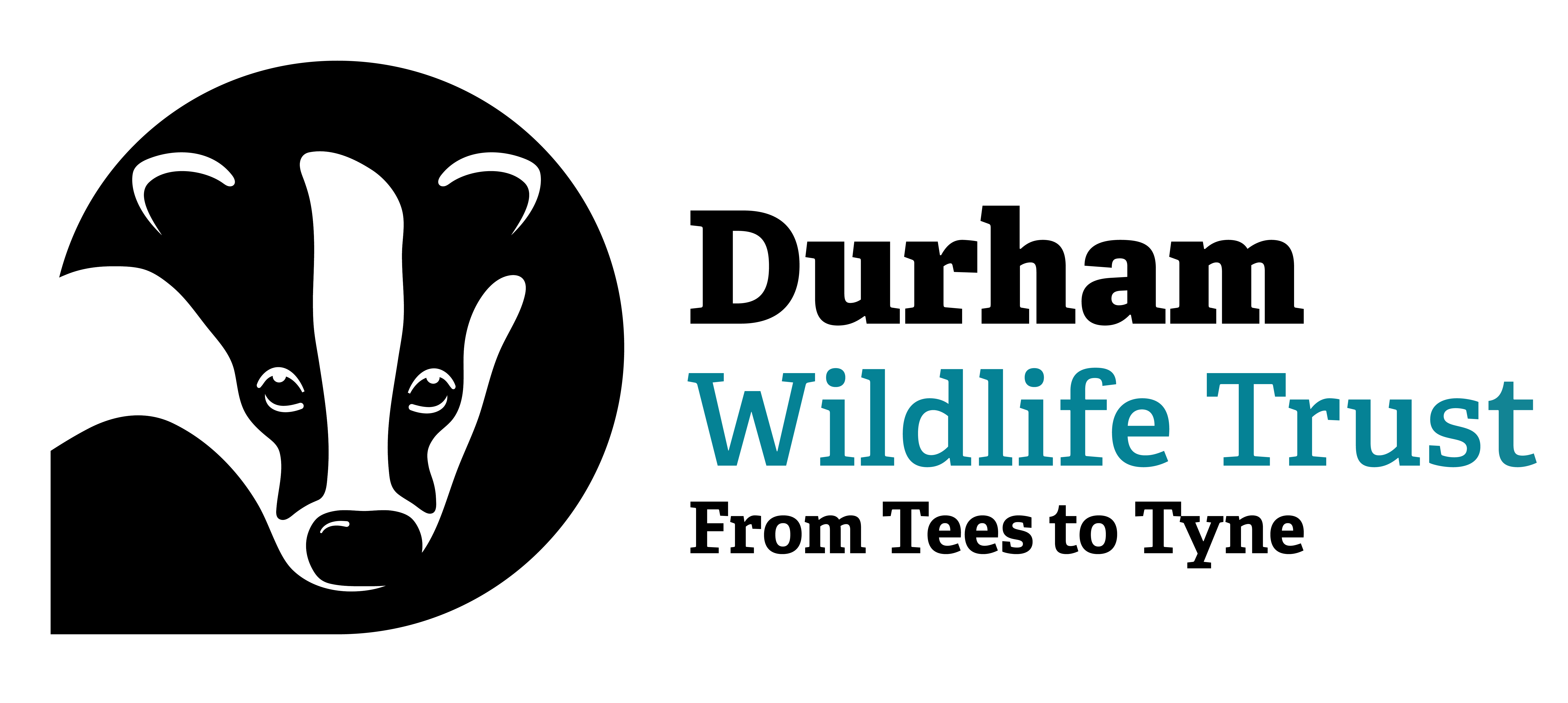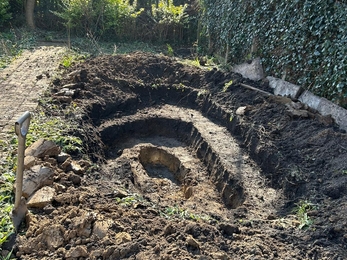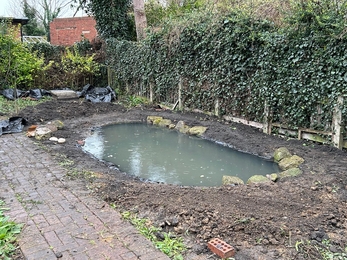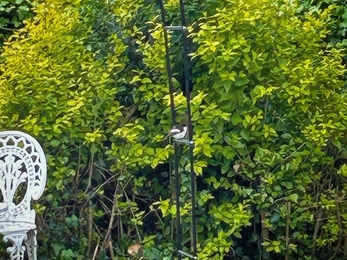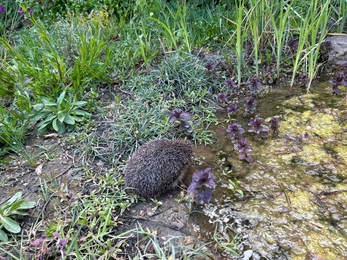In January 2024 we moved into a new house, our first with a garden big enough for a pond. As a child I helped build a pond in my dad’s garden and then spent hour after hour gazing into the water at the world below the surface. So, to finally have my own pond to while away the hours was a small dream. The garden was a blank canvass, initially overgrown it held some potential for wildlife, and importantly for me and wildlife, a bit of space for a pond. Given the room we had after removing a few self-seeded saplings and a bit of bramble, I took up as much space as I could with the pond, a little too much if you ask my partner! She was sceptical but has since warmed to it considering what it has brought to the garden. It’s not perfect and if I were to build one again I would change some things but it’s certainly doing what we wanted and more. The pond was finished and filled in late March 2024 but what has happened since has been nothing short of amazing!
Build it and they will come
First spring/summer
We live in the middle of Sunderland, in a housing estate not too far from a public park and a school. While there are many trees around there is very little in terms of aquatic habitat on our doorstep, but our next-door neighbour does have a small, rather overgrown and shaded pond. If nothing else we knew there would be newts and frogs nearby after we talked about the wildlife in his garden, but by his own admission his pond had become overgrown and shaded so some species had long gone. As we added plants to the pond we started to notice the wildlife moving in. First a fleeting glimpse of a newt! I wont lie, the volume at which I excitedly shouted "newt!" across the garden to my partner was a little excessive. Soon after there were groups of water flea, flatworms, and water slater, no doubt hitchhiking in on some of the donated and purchased plants. Water boatman, pond skaters, water beetles and whirligig beetles were all in and out of the pond. Somehow, the larvae of a great diving beetle found its way into the pond, relentlessly hunting. We spotted a frog who had seemingly taken up residence despite the vocal frogs in the pond just next door, maybe he liked the peace and quiet.
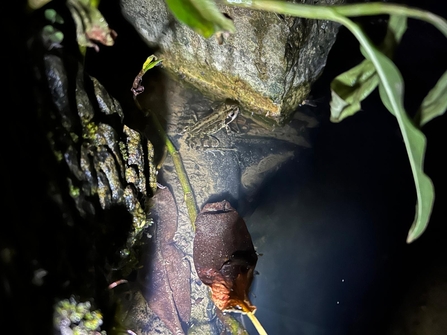
Later in the summer, as plants slowly began to find their feet, we had an influx of dragonflies and damselflies visiting the garden and using the pond. First, a female broad-bodied chaser laying her eggs, hovering and dipping her abdomen into a patch of water milfoil. Common blue and large red damselflies occasionally passed through. We also had multiple common darters, resting on the path and darting up to grab flying insects. However, my favourite moment was when my son rushed into the house shouting "daddy there’s a dragonfly and it’s landed!". Southern hawkers have a curious strategy of laying their eggs on moss and wet wood close to but not actually in the water. Despite being large and colourful it was surprisingly camouflaged on the rock as you can see by the image. We watched one lay eggs for a good half an hour on a mossy rock on the edge of the pond. A magical moment.
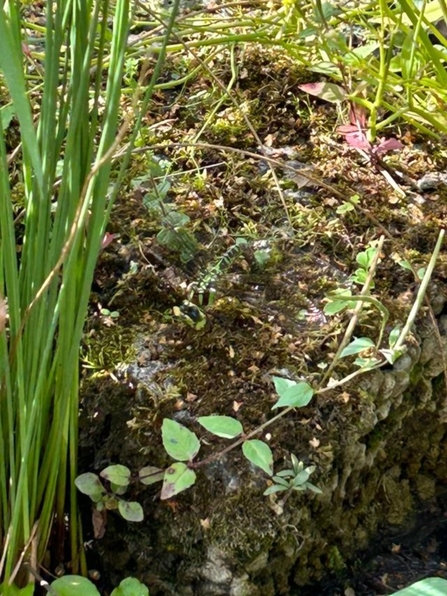
The second year
I would confess to being an impatient man. I spent hours in the garden wishing away the winter, wondering how the pond will look in the spring and summer. How the greater spearwort will look towering over one corner, whether more of the yellow flag iris will flower, and at what stage the arrowhead will finally emerge (still waiting on that!). But, good things do come to those who wait! While plants slowly started to show signs of early growth we were blessed with frogspawn! Two clumps no less! However, it didn’t take long before an element of dread set in with what fate awaited the eggs.
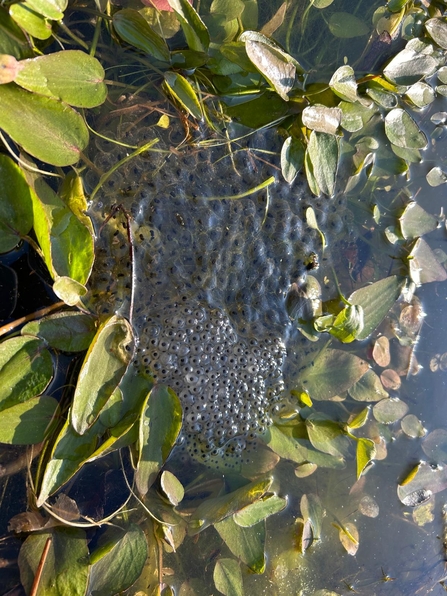
Adult newts eat frog eggs and tadpoles, and true to their nature, that’s unfortunately exactly what they did. Every single egg. Disaster for the frogs, but triumph for newts coming out of hibernation with a much-needed meal. I’m unsure how to feel about the loss/gain of this relationship but it is nature at its most honest. Oddly we seem to have no smooth newts in our pond, but palmate newts. A little less common and often found in the uplands but by some quirk a stronghold in our corner of Sunderland! A little smaller than smooth newts, with females looking similar but males are markedly different in breeding season, lacking a crest or dark colour but instead having pronounced tail spots and a curious ‘string’ at the end of their tail. Palmate are also the only native UK newt species to have webbed feet, but only the hind feet. As the spring has gone on I have watched the newts perform their courtship in which males will use their tails to waft pheromones at females. At one point we counted nine newts under torchlight, no doubt others hid under cover.
Recently I got confirmation of something I wished for, Newt eggs!! Loosely hidden by a female in amongst the leaves of an oxygenator. Soon after we found a newly hatched ‘baby’ newt in some debris I pulled from the pond! In said debris was also another marvel, a very small dragonfly larvae! Likely to be the broad-bodied chaser from last summer. Hardly the prettiest creatures, dragonfly larvae can spend years in the water before emerging into dragonflies for just a matter of weeks. I would implore anyone to look up how dragonfly nymphs feed, with some having telescopic feeding parts to grab unsuspecting prey.
That’s not all
When water is mentioned in a garden my first thoughts are drawn to amphibians and aquatic insects. But the reality is that a whole plethora of animals not just use but need freshwater. Last spring, we had a remarkable visit from a male pied flycatcher who came to drink from the pond on his epic migration from Africa. We have daily visits from several species of garden birds using the pond to drink and bathe. Their feather dust swirling across the surface of the pond. In summer we sit out in the evening as swifts scream above the gardens eating flying insects (many of which emerge from freshwater) before passing the baton over to bats at dusk. We have even recently seen a hedgehog drinking from the pond in late afternoon this spring! No doubt a thirsty mother struggling to find a drink in the dry weather.
It is said that if you want to attract wildlife to your garden there is no better way then introducing freshwater. It is no lie. Trust me when I say that there is no such thing as ‘too small’. Sunken buckets in a forgotten corner of the garden may go a little stagnant but will provide a drinking spot and niche habitat for several species of flies, particularly for hoverfly larvae. Bird baths can provide vital drinking water for birds through dry spells (be sure to keep them clean). And as I have just highlighted, even new and relatively small ponds will bring so much extra life into the garden. There is no better way to turn a garden into a wildlife haven.
